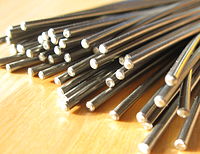
Photo from wikipedia
Abstract Highly Ni-rich NiTi alloys have attracted increasing attention as new candidates for bearing materials owing to their high hardness, low density, good corrosion resistance, and good dimensional stability. The… Click to show full abstract
Abstract Highly Ni-rich NiTi alloys have attracted increasing attention as new candidates for bearing materials owing to their high hardness, low density, good corrosion resistance, and good dimensional stability. The main phases of the Ni55Ti45 (at%) (60NiTi) alloy consist of B2-NiTi matrix, equilibrium Ni3Ti, metastable Ni4Ti3 and Ni3Ti2, and a small amount of Ti2Ni phase. The ultra-high hardness of 60NiTi was attributed to the high volume fraction of nanoscale Ni4Ti3 phase and significant internal strain resulted from its coherence with the NiTi matrix. In this study, a series of 60NiTi-V alloys were prepared to study the effect of V addition on the microstructure, mechanical properties and oxidation performance of 60NiTi. The additional V enhanced the transformation from Ni4Ti3 phase to Ni3Ti2 and Ni3Ti phases. When the V content exceeded 3 at%, a grid-like Ni3Ti2 phase was formed in the alloy, and when the V content reached 10 at%, the formation of Ni3Ti phase was promoted. Moreover, the morphology and distribution of Ni3Ti2 phase changed with changing V content. The hardness of the alloy increased with increasing V content, whereas the fracture toughness and tensile strength increased at first and then decreased, owing to the solid solution strengthening effect of V and strengthening effect of Ni3Ti2 phase. At 500 °C, the oxidation resistance of 60NiTi-V alloys with V contents of less than 3 at% V was higher than that of binary 60NiTi. Conversely, the oxidation of the 60NiTi-V alloy with a V content of 3 at% was more severe than that of binary 60NiTi at a high oxidation temperature of 800 °C, because V promoted outward Ni diffusion. Therefore, a V content of less than 3 at% was effective for improving the microstructure and properties of highly Ni-rich NiTi alloys; moreover, in this study, we provided a new idea for strengthening highly Ni-rich NiTi alloys and expanding their applications.
Journal Title: Journal of Alloys and Compounds
Year Published: 2021
Link to full text (if available)
Share on Social Media: Sign Up to like & get
recommendations!